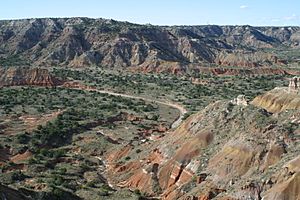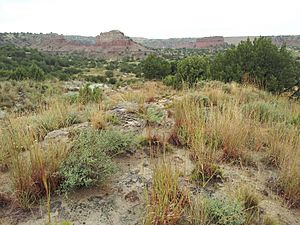Battle of Palo Duro Canyon facts for kids
Quick facts for kids Battle of Palo Duro Canyon |
|||||||
|---|---|---|---|---|---|---|---|
| Part of the Red River War, American Indian Wars | |||||||
 Palo Duro Canyon |
|||||||
|
|||||||
| Belligerents | |||||||
| Cheyenne Comanche Kiowa |
|||||||
| Commanders and leaders | |||||||
| Ranald S. Mackenzie | Poor Buffalo Lone Wolf |
||||||
| Strength | |||||||
| 400 cavalry | 1500 warriors | ||||||
| Casualties and losses | |||||||
| 1 wounded | 15 killed at Tule 50-60 killed at Palo Duro |
||||||
The Battle of Palo Duro Canyon was an important battle during the Red River War. It was a big victory for the United States Army. On September 28, 1874, U.S. Army soldiers led by Ranald S. Mackenzie attacked a large camp of Plains Indians in Palo Duro Canyon, Texas.
Why the Battle Happened
In the summer of 1874, groups of Comanche, Cheyenne, Arapaho, and Kiowa warriors left their assigned lands, called reservations. They were led by Chief Lone Wolf. They went to Palo Duro Canyon in the Texas Panhandle to find safety. They were also gathering food and supplies there for the coming winter.
Colonel Ranald S. Mackenzie was leading the 4th U.S. Cavalry. He left Fort Clark, Texas on August 15. His orders were to follow the Native American groups wherever they went.
Mackenzie divided his soldiers into three main groups. These groups moved across the land, trying to find the Native American camps. By September 25, Native Americans began to gather around Mackenzie's troops. On the night of September 26-27, they attacked near Tule Canyon. About 15 warriors were killed, including the Kiowa chief Woman Heart.
Earlier in September, Black Seminole Scouts working for the 4th Cavalry were ambushed by Comanche warriors. The scouts managed to escape and told Mackenzie where the Comanche were. This put Mackenzie on high alert.
The Battle Begins

Early on the morning of September 28, two of Mackenzie's Tonkawa scouts found a fresh trail. Mackenzie and his soldiers followed it. At dawn, they reached a huge canyon where they could see the Native American lodges (homes).
Mackenzie's cavalry soldiers got off their horses. They led their horses single-file down a narrow, winding path into the canyon.
Mackenzie's troops first attacked Chief Lone Wolf's Kiowa camp. The Native Americans, including Chiefs Poor Buffalo and Lone Wolf, managed to escape. They left behind their belongings and horses. They climbed up both sides of the canyon.
The Native American warriors began to shoot at the soldiers from high above. The soldiers found themselves in a tough spot. Some of the soldiers started to retreat back up the steep cliffs. Others pulled down the lodges and chopped up the lodge poles. They burned all the Native American belongings in huge bonfires.
Almost 2,000 horses were captured. The soldiers moved them out of the canyon by 4 PM. Mackenzie's troops made it back to their supply camp in Tule Canyon the next morning.
What Happened After the Battle
Losing the Palo Duro camp was a huge blow for the Native Americans. They lost their safe place and all their supplies for the winter. Some horses escaped with the Native Americans onto the plains. However, Mackenzie captured between 1,500 and 2,000 ponies. He had them killed so they couldn't be used by the Native Americans again.
Few soldiers were hurt in the battle because it was a quick victory. But without enough horses or supplies, the tribes could not survive the winter. Many returned to the Fort Sill reservation by November 1874. Lone Wolf's Kiowas did not return until February 1875.
This battle was the last major fight of the Red River War. It was also one of the final battles of the Texas-Indian Wars. Colonel R. S. Mackenzie recommended seven white soldiers and Adam Paine of the Black Seminole Scouts for the Medal of Honor.

